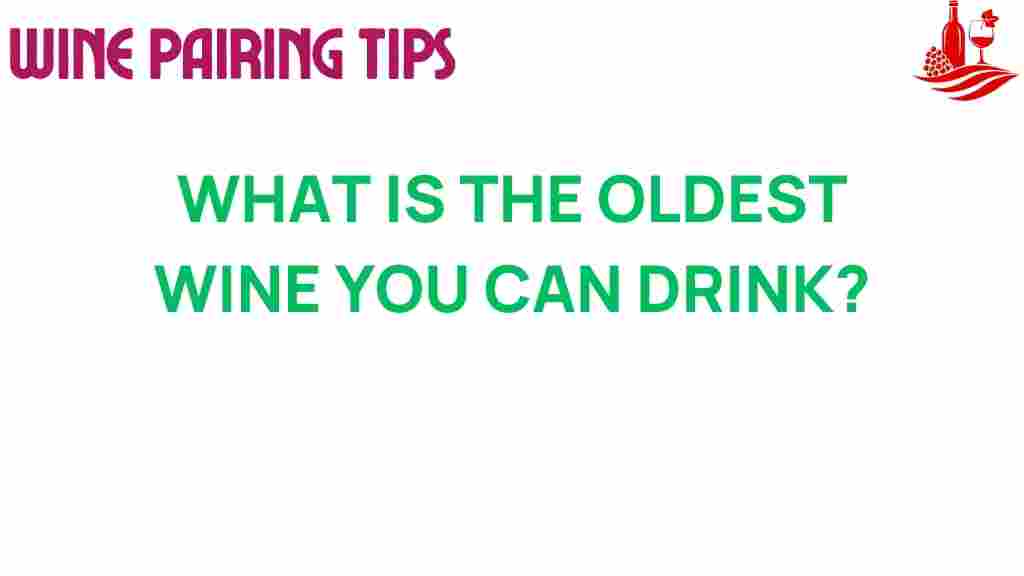Uncorking History: What Is the Oldest Wine You Can Drink?
The world of wine is steeped in history, with some bottles aging for decades, if not centuries. For wine enthusiasts, the allure of tasting the oldest wine captivates the imagination. But what truly constitutes the oldest wine you can drink? This article delves into the fascinating world of historical wines, exploring the vintage treasures that have survived through time, the aging process, and sommelier insights into wine preservation and tasting.
The Allure of Old Wines
Old wines hold a unique charm for collectors and connoisseurs alike. They tell a story of tradition, culture, and the passage of time. Many wine enthusiasts dream of tasting a rare vintage that has been carefully preserved, often leading to questions about the oldest wine still suitable for consumption.
Understanding Vintage
Before we explore the oldest wines, it’s essential to understand what vintage means in the wine world. Vintage refers to the year the grapes were harvested and the wine was produced. A wine’s vintage can greatly influence its flavor profile and aging potential. For example, some vintages are renowned for their exceptional quality and longevity, making them prime candidates for collectors.
The Oldest Wine: A Journey Through Time
When we talk about the oldest wines, we are often referring to bottles that have not only survived but are still drinkable. Here are some notable examples:
- Rüdesheimer Apostelwein 1540: This German wine is believed to be the oldest known bottle still in existence. Stored in a family cellar for centuries, it is now housed in the wine museum in Rüdesheim, Germany.
- Old Vines of Bordeaux: Some vineyards in Bordeaux, France, have been producing wine since the 18th century. While not all bottles are still available, wines from these older vintages are sought after for their historical significance.
- Vin Jaune: This unique French wine from the Jura region can age for decades and is known for its oxidative aging process, which enhances its complex flavors.
Rare Vintages Worth Exploring
Besides the oldest wine, several rare vintages are noteworthy for their history and aging potential. Here are a few to consider:
- Château Lafite Rothschild 1787: A bottle that once belonged to Thomas Jefferson, this wine is one of the most expensive ever sold.
- Domaine de la Romanée-Conti: Known for its exceptional Pinot Noir, this vineyard produces wines that are highly coveted and can age beautifully.
- Madeira: Some Madeiras from the 19th century are still drinkable today, showcasing the incredible preservation capabilities of this fortified wine.
The Aging Process: How Wines Mature
The aging process of wine is crucial in determining its quality and flavor profile. Several factors influence how a wine develops over time:
- Type of Wine: Red wines generally age better than white wines due to their tannin content, which acts as a natural preservative.
- Storage Conditions: Ideal storage conditions include a consistent temperature, humidity control, and minimal light exposure.
- Closure Type: Cork closures allow for a small amount of oxygen to interact with the wine, which can enhance aging.
Wine Preservation Techniques
For those interested in preserving their own wines, understanding wine preservation techniques is essential. Here are some tips:
- Cellaring: Store wines in a wine cellar or a dedicated wine fridge to maintain optimal conditions.
- Temperature Control: Keep wines at a consistent temperature, ideally around 55°F (13°C).
- Humidity Management: Aim for a humidity level of around 70% to prevent corks from drying out.
Wine Tasting: An Experience to Savor
Tasting old wines can be a memorable experience. However, it requires a delicate approach. Here are some sommelier insights for tasting vintage wines:
- Preparation: Allow the wine to breathe. Decanting can enhance the flavors and aromas.
- Glassware: Use appropriate glassware to fully appreciate the wine’s characteristics.
- Sensory Evaluation: Pay attention to the wine’s appearance, aroma, taste, and finish.
Troubleshooting Old Wine Tasting
While tasting old wines is exciting, it can also present challenges. Here are some troubleshooting tips:
- Corked Wine: If a wine smells musty or off, it may be corked. This is due to TCA contamination.
- Oxidation: If a wine has a brownish hue and smells like vinegar, it may have oxidized.
- Flat Taste: If the wine lacks vibrancy, it may be past its prime.
Conclusion: The Legacy of Old Wines
The quest for the oldest wine is not just about sipping a rare vintage; it’s about connecting with history and experiencing the evolution of winemaking. From the ancient vineyards of Europe to the modern-day collectors, the legacy of old wines continues to inspire. Wine enthusiasts who appreciate the nuances of historical wines understand the importance of preservation and the delicate aging process. Whether you’re a novice or a seasoned sommelier, tasting these rare vintages can be a profound journey into the past.
For more information on wine preservation techniques, check out this guide to wine storage. If you’re interested in exploring more about historical wines, visit this resource for insights and tips.
Next time you uncork a bottle, consider the history behind it and savor the taste of time.
This article is in the category Tasting and created by Wine Pairing Tips Team
